| Columns Retired Columns & Blogs |
Polk RTA 11t loudspeaker Measurements
Sidebar 3: Measurements
Regarding measurements, I use a mixture of nearfield, in-room, and quasi-anechoic FFT techniques (using the MLSSA system from DRA Labs) to investigate objective factors that might explain the sound heard. (Stereophile's measuring microphone is a calibrated B&K/DPA 4006.) The speakers' impedance phase and amplitude were measured using Stereophile's Audio Precision System One.
The plot of the RTA 11t's impedance magnitude and phase against frequency (fig.1) suggests that the two different-mass passive radiators actually act as one, the minimum in impedance value at 37Hz indicating their combined tuning. The dip below 6 ohms between 85Hz and 440Hz, with a minimum value of 4 ohms, confirms Polk's 6 ohm rating for this speaker, though the treble region does stay above that value.
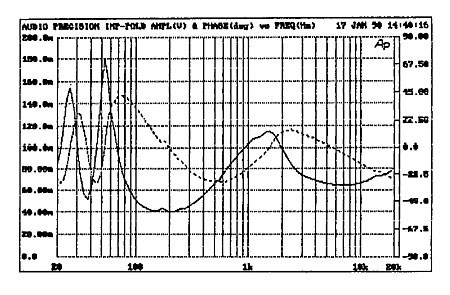
Fig.1 Polk RTA 11t, electrical impedance (solid) and phase (dashed). (2 ohms/vertical div.).
The two small dimples in the magnitude trace (solid line) around 150Hz and 250Hz are echoed in the phase response (dotted line), normally an indication of resonant behavior. Driving the speaker with a swept sinewave revealed a series of strong cabinet vibrations at 213, 240, 260, and 290Hz, these much worse in degree than any of the other speakers I listened to this month. Listening close to a speaker sidewall gave me the impression that I was stepping between these discrete frequencies even though the sinewave was actually being swept. Such strong resonant output from a speaker's enclosure can have a serious negative effect on its ability to accurately reproduce musical pitch information in the lower midrange, in my experience. I conjecture that the exact pitch of the musical note the speaker is being asked to reproduce will be disturbed by the subjective pulling of the reproduced frequency to the frequencies of nearby low-Q resonances. This is analogous to the way a violin with a severe "wolfnote" will sound rather sour in that region. The cabinet was considerably more inert an octave lower, though I did find that the passive radiators had output more than I expected around 160Hz. This probably correlates with the dimple in the impedance plot at this frequency, but it seemed to be subjectively innocuous.
Fig.2 shows the anechoic section of the RTA 11t's impulse response as calculated by MLSSA. The measuring microphone was on the listening axis, level with the cabinet top, at a distance of 48". (The speaker was sitting on a 24" stand for this measurement so that the first reflection, from the floor, could be delayed as much as possible.) The shape of the corresponding step response (fig.3) shows that the drive-units are connected with the same polarity, and there is a complicated pattern of ringing extending out to the edge of the time window.
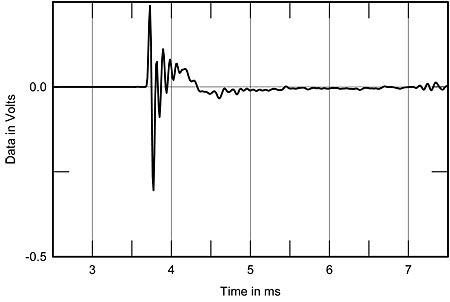
Fig.2 Polk RTA 11t, impulse response on tweeter axis at 48" (5ms time window, 30kHz bandwidth).
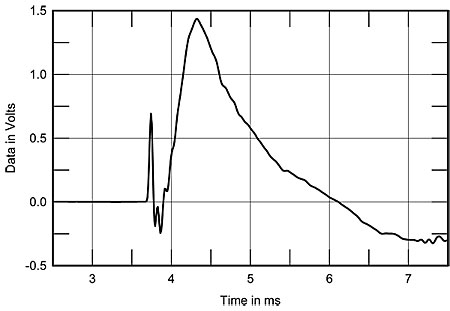
Fig.3 Polk RTA 11t, step response on tweeter axis at 48" (5ms time window, 30kHz bandwidth).
A speaker's impulse response contains within it its frequency response, connected by the mathematics of the Fourier Transform. FFT analysis of the impulse of fig.2 gives the response shown as the black trace to the right of fig.4. An overall falling trend from the lower midrange to the mid treble is broken by a significant lack of energy in the crossover region and a peak centered on 12.5kHz. The response plummets above that frequency, implying that the tweeter has a severe lack of HF extension. (The measurement bandwidth was 30kHz.) Repeating the measurement on the tweeter axis gave the red trace shown in fig.4, showing that the lack of extreme highs was not due to the particular measurement position. The curve's very similar nature, however, reveals that the 11t has good vertical dispersion.
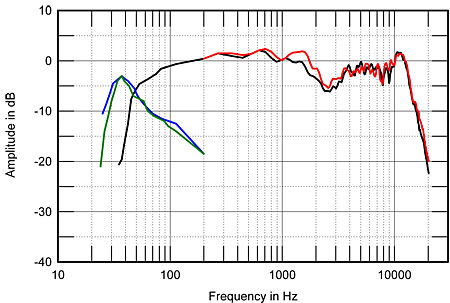
Fig.4 Polk RTA 11t, anechoic response on listening axis at 48" (black), and on tweeter axis (red), corrected for microphone response, with the nearfield woofer (black), upper ABR (blue) and lower ABR (green) responses, plotted below 200Hz.
The curves to the leftt of fig.4 show the responses of the upper woofer (black trace) and the two passive radiators (upper radiator blue, lower radiator green) measured in the nearfield: ie, with the microphone almost touching the diaphragms. The woofer actually appears to start its gentle rolloff quite high in frequency, though it doesn't reach its half-power point until 50Hz. As suggested by the impedance measurement, the two passive radiators have almost identical outputs centered on 37Hz, though the "low-resonance" unit rolls out slightly faster below that frequency, as can be seen from the plots.
As might be expected from the 11t's dual woofers and dual passive radiators, low-frequency linearity is significantly better than either of the two miniature speakers reviewed this month. Even at a high 96dB spl, only low-order harmonics were measurable above the noise floor. At 50Hz, even the highest in level, the second and third harmonics still measured less than 1% each. Peculiarly, the second harmonic was higher in level for the 100Hz tone at –37.9dB, 1.25%. As the passive radiators are not significantly contributing to the speaker's output at this frequency, this suggests some asymmetry in the woofer's behavior.
Looking at the spatially averaged in-room response (fig.5), which minimizes the effect of low-frequency room resonant modes, the nearfield-measured bass performance translates to good 40Hz extension, with a rapid roll-out below the passive radiators' resonant frequency. An excess of energy in the upper bass can be seen, however, as can one in the 630Hz band. Again there is an overall lack of energy in the crossover region, while the peak centered on 12.5kHz noted on the anechoic traces results in a significant boost in this region in-room, noticeable on all axes. This doesn't mean that the 11t will sound bright, brightness being associated with peaks an octave or more lower in frequency. And in fact the lack of energy in the presence region might be expected to lend the speaker rather a dull, uninvolving nature. However, the top-octave boost will add a spitty quality to record noise.
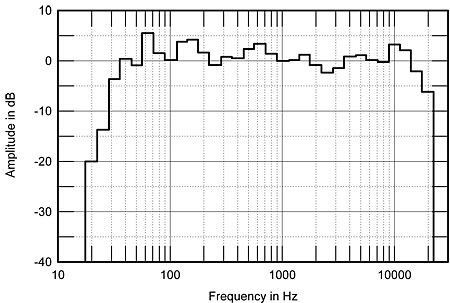
Fig.5 Polk RTA 11t, 1/3-octave, spatially averaged response in JA's listening room.
The final graph, fig.6, shows the RTA 11t's cumulative spectral decay plot assessed on the speaker's tweeter axis. These "waterfall" displays indicate the presence of resonant problems by ridges running parallel to the time axis: as the impulse decays, these are the frequencies where the speaker continues to ring. Compared with the similar plots for the other two speakers reviewed this month, neither of which is without problems, fig.6 reveals the Polk speaker to be similarly mediocre, notwithstanding its significantly higher price. In some respects, however, it is actually worse than the other two. Although there is an initial clean drop of 6dB or so in the treble, there then develops a number of individual treble resonances, these persisting longer than the treble resonances typical of the Monitor Audio and Ambiance speakers. In particular, the regions between 2700Hz and 4kHz and between 8kHz and 12kHz are very lively. The peak in the latter region is probably associated with these resonances, but its shape does suggest that some other factor may also be at work, maybe a diffractive mechanism.
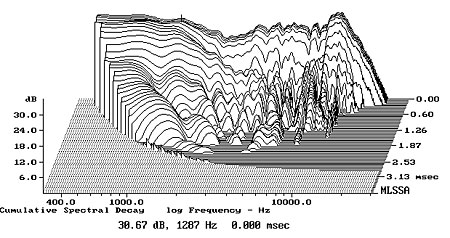
Fig.6 Polk RTA 11t, cumulative spectral decay plot on tweeter axis at 48".
To sum up the subjective meaning of these measurements is difficult, as often they will tend to produce opposing effects. The implication that the presence region will sound rather laid-back, for example, derived from the frequency response curves, has to be put against the fact that fig.6 reveals there to be resonant problems in this region that might well counteract this tendency. Overall, however, I felt that while its overall response below the top octave might be flat in broad terms, these measurements did reveal the RTA 11t to have a number of problems that undoubtedly contributed to its musically uninvolving nature.—John Atkinson
- Log in or register to post comments




































